There’s something cathartic about brushing your teeth. Whether you’re staring at yourself bleary-eyed in the morning or getting ready for bed (aka, following the dentist’s recommended twice-a-day brushing they never let us forget about), it’s one of the few times of the day that you’re still. Just hanging out in the bathroom, singing your favorite song in your head so you brush for at least two minutes, and daydreaming about life. Unless you’re running late for work, then you’re probably running around the house and multitasking. As more and more people move from manual to electric, though, there’s a serious chance you could be brushing with a moldy electric toothbrush.
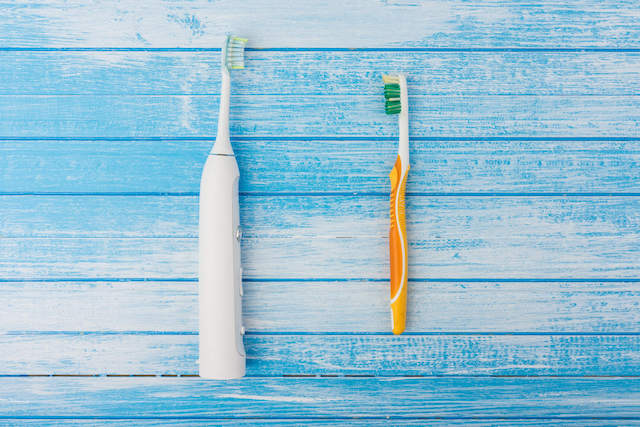
In all fairness, both manual and electric toothbrushes can get moldy, so we’re not even going to touch that debate today! The electric ones are just a bit different because they come equipped with a rechargeable base, which happens to be a great location for mold growth.
The last thing we, or the dentists, want is to brush our teeth with mold. Honestly, you’re probably feeling a little squeamish just thinking about it. Understandably! That’s seriously icky and not the kind of teeth cleaning we’re looking for. To help prevent a mouth full of fungus, those little teeth-scrubbing tools need some extra care and attention so you don’t end up with a moldy electric toothbrush on your hands. And in your mouth. Eeek!
Seriously, Though, The Toothbrush?
Yeap! An electric toothbrush makes a perfect home for mold to settle in and grow. Not to mention it’s located in one of mold’s favorite rooms in your house.
Let’s set the scene. The 100,000+ species of mold identified so far reproduce by creating microscopic spores that they release into the air.¹’² The goal of these spores is to find a nice little habitable area that they can put down roots in (literally) and begin to grow. Picture the seeds of a dandelion puff and you’ve got the right idea. Mold spores (seeds) just happen to be smaller than the eye can see.
All a mold spore needs to grow are four simple components:³
- Oxygen (they need very little, so this one hardly counts)
- Food (they eat pretty much anything and everything)
- Temperature (most prefer 40-90 degrees Fahrenheit, but some species can live in extremes)
- Moisture (often the missing piece of the puzzle)
When the stars align and these four ingredients for life are present for at least 24 hours, poof, there’s now a living mold colony. So, what does that mean for you?
As the mold spores are released into the air, they ride that current wherever it leads. Sometimes that air flows right into your own home. If they’re lucky enough. They won’t just attach to the surface of your front door, they’ll make their way into more habitable areas like your bathroom. Just think about it- there’s plenty of oxygen, it’s a temperature-controlled room, tons of yummy (for mold) particles, and boy is there moisture. Between the running shower, sink faucet, flushing toilet, and water puddles, wetness abounds in these areas.
With those conditions, mold can easily become your everyday bathroom partner, which is not good for your health!
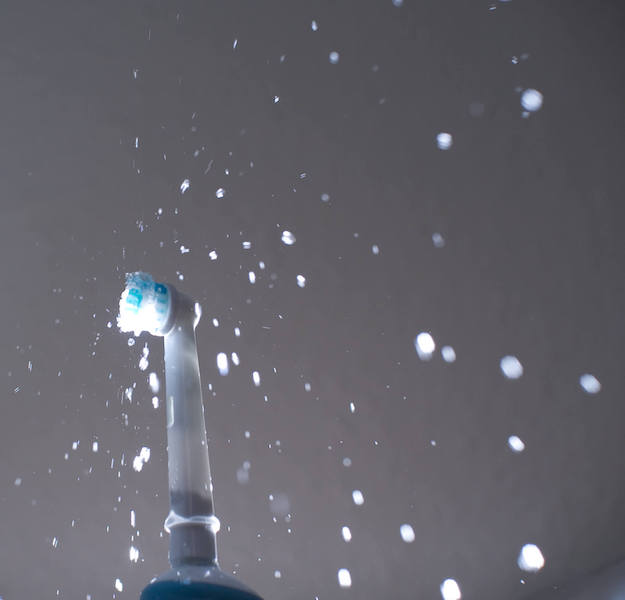
The Toothbrush Element
Now picture that toothbrush. Not only is the room perfect, but the electric toothbrush itself is prime real estate for mold spores. It’s constantly wet and there are tons of particles on it from your mouth and the air.
With an electric toothbrush specifically, that base is also a problem. It’s constantly inundated with water as it drips down from the toothbrush head and it’s covered in any particles that are not rinsed off after brushing. Hard water from the sink can also lead to mineral buildup as it pools in the area. Not to mention, it probably doesn’t get a lot of cleaning action, so all of this can easily snowball into a gross pile of gunk.
Before you know it, you’ll be looking down at a moldy electric toothbrush while you’re brushing. Cue attempting to fight off sickness and a panic attack because that fungus among us is so not good for your health!
A Moldy Electric Toothbrush Health Debacle
Mold exposure can cause a range of health effects depending on the individual. Researchers are still trying to determine exactly how mold affects our bodies, but aspects like genetics, species of mold, length of exposure time, and the state of the immune system all play a role. Some species of mold can also produce microscopic toxins called mycotoxins, which complicate things even further because they’re also toxic to our health. ⁴
Essentially, there are a lot of factors to nail down. What they do know is that anyone with a compromised or developing immune system is more likely to develop reactions faster and to a greater extent. As these microscopic foreign particles enter our body, either by being ingested or breathed in, they elicit an immune system response to get rid of them as soon as possible. When you encounter a few spores throughout the day, that’s usually not a big deal for your immune system. A high volume of spores trapped within the confines of a home or stuck to the toothbrush you’re about to put in your mouth is a much bigger task.
Over time, the immune system can get bogged down, which triggers a long list of adverse health reactions. ⁵’⁶’⁷’⁸ Again, it depends on the individual for which symptoms may occur.
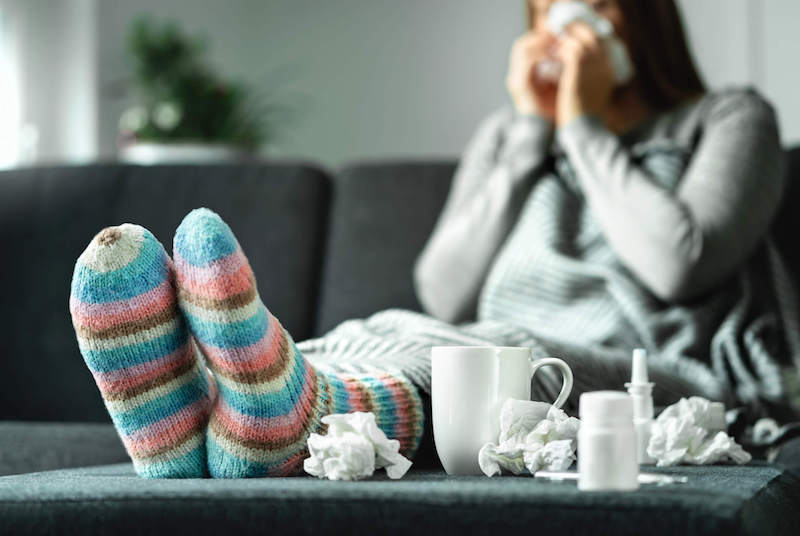
Some common symptoms of mold exposure include:
- Coughing
- Runny nose
- Chronic fatigue
- Shortness of breath
- Digestive issues
- Brain fog
- Respiratory problems
- Rashes
- Neurological issues
The potential for symptoms is enough of a reason to prevent a moldy electric toothbrush, but the yuck factor also helps.
Preventing A Moldy Electric Toothbrush
Stopping mold from growing on your toothbrush involves eliminating the components that spores need to live. Removing the ingredients for life ensures that a spore stays a spore and doesn’t transition into colonized mold. Growing mold is a much bigger nuisance. Getting rid of the microscopic particles themselves is also a crucial part.
The following steps will help ensure you don’t brush with a moldy electric toothbrush.
1. Thoroughly rinse it off after every use.
The goal here is to get rid of as many particles as possible that are stuck on from brushing. No particles mean no food sources for mold growth. It also helps prevent particle buildup, which is essentially just an endless buffet for spores.
2. Shake, Shake, Shake It.
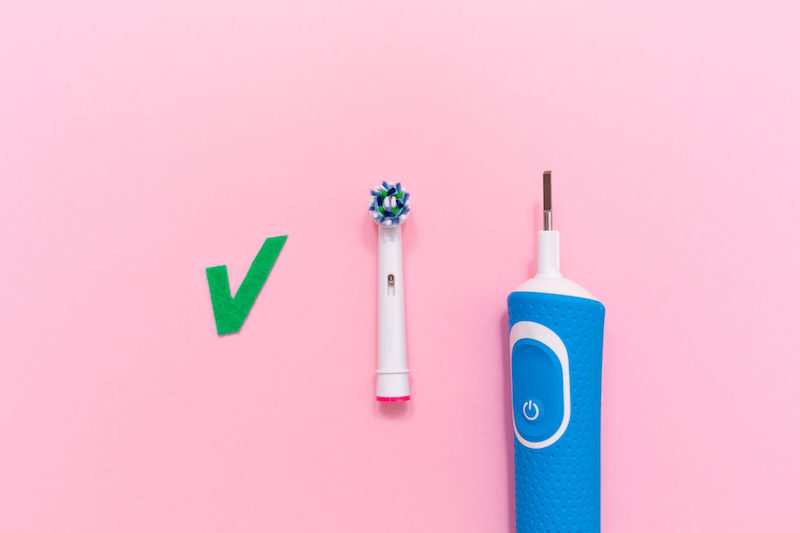
After you’ve given it a good rinse, tap it against the side of the sink a couple of times to get rid of as much water as possible.Then, grab a rag and wipe down the body itself. You’re looking to eliminate as much water as possible from the brush head and stop any from its way down into the base. No moisture means less of a chance for mold to grow. The best option is to keep the head separate from the body when not in use, but make sure to store it upright so the bristles dry completely. This extra step helps ensure water doesn’t drip down onto the base.
3. Store it like a pro.
Where you keep your electric toothbrush is key.
You’re looking for an area far from the toilet (because toilet particles are just nasty and should NOT make their way into your mouth) and with good airflow. Stagnant air won’t help the brush dry out quickly, and time is of the essence with mold’s ability to begin growing in as little as 24 hours. Every bathroom is different, so take a look around to see what area would make a perfect toothbrush home.
4. Deep clean once a week.
We don’t typically think about cleaning the tool that cleans our teeth, but we should! Especially electric toothbrushes that have parts that we keep for years. To clean your trusty tooth scrubber, take off the head and soak it in a botanical cleaner like hydrogen peroxide or a white vinegar solution for at least 30 minutes or overnight, and then thoroughly rinse it off after the soak.
For the rest of the toothbrush, either grab a spray bottle or get a cup and fill it with the botanical cleaner or Benefact. The only other tool you’ll need is a small brush (like a manual toothbrush). Ironic, right? Spray the base and body down (but avoid the plug part) or dip the brush in the solution and then immediately get to scrubbing. Make sure to pay careful attention to all of the cracks and crevices where water and particles can build up. Use a little pipe cleaner if you need to get to the super hard-to-reach areas. Once you’re finished, wipe everything with a microfiber towel. They’re 100 times better at wiping away tiny particles like mold spores and toxins. Allow all of the parts to dry completely before reassembling.
5. Replace the head on time.
The American Dental Association recommends replacing the head every three to four months, but the more often the better.⁹ Eventually, the bristles will get deformed, which makes them less effective and more prone to retaining water. Trapped water is a mold spore’s dream.
6. Create the best bathroom conditions.
Another way to help ensure you don’t develop a moldy electric toothbrush is to reduce the living conditions for mold in the bathroom as much as possible. Moist air can lead to toothbrushes that don’t actually get dry (a spore’s dream) and mold growth within these rooms skyrockets the chance that a mold spore will luck out and manage to slip onto your toothbrush and start to grow. Turning on the exhaust fan and cracking the door while bathing, drying towels and bathmats, keeping the humidity level between 30 and 50 percent, cleaning frequently, and wiping up any pooled water as soon as possible are all ways to keep your bathroom mold-free. ¹⁰
Collectively, all of these actions will help ensure that you’re not hosting a moldy party in your mouth. Makes all the extra work worth it when you think of it that way, right?

Eeek, Is That A Moldy Electric Toothbrush?!
Mold spores are sneaky, persistent, and tenacious. They will do everything in their power to start growing and wreaking havoc on your toothbrush and your health. Sometimes, no matter how much you work to prevent mold growth, a lucky spore will manage to slip in and start to grow.
If you notice mold on your electric toothbrush, the absolute best option is to just toss it. It’s always better to err on the side of caution.
That being said, those things can be seriously expensive, and throwing them out just isn’t an option. In situations such as this, go ahead and throw out the head, then replace it with a brand new one. That’s the part that’s regularly inside your mouth, and it’s also exceptionally difficult to get clean, so it’s best to just start fresh.
Before attaching the new head, though, you’ve got to tackle the body and the base. Using that white vinegar or Benefact, clean both as mentioned in the maintenance steps above, except you’re going to want to complete the entire process at least three times. Mycotoxins are particularly difficult to remove from surfaces, so thoroughly scrubbing and wiping away multiple times helps ensure these tiny toxic particles are gone, along with the moldy particles. Allow everything to dry completely before using.
After this process, keep a close eye on your toothbrush. If the mold grows back quickly and you’re staring at a moldy electric toothbrush yet again, you can try to clean it a second time, but it might be time to start thinking about investing in a brand new toothbrush. Avoiding brushing with a moldy electric toothbrush is worth it!
Keeping Those Pearly Whites Mold-Free
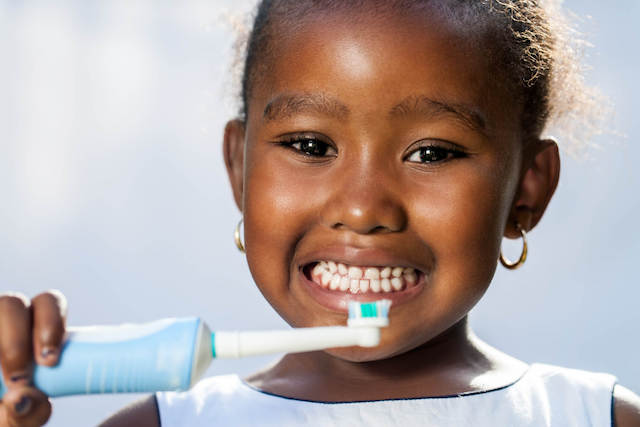
Dental hygiene is super important to help keep our teeth in tip-top shape and to keep our mouths healthy.Plus, that minty fresh breath! When mold comes along for the ride, though, it kind of mitigates that healthy aspect.
Avoiding a moldy electric toothbrush ensures that all of your hard work keeping those teeth in peak condition doesn’t go to waste. Not being grossed out is also a pretty big perk. Make sure your favorite tooth scrubbing tool is safe and ready for action by preventing as many moldy opportunities as possible, and don’t forget to tell the rest of your family and friends as well to save them from moldy mouth parties too!
Citations:
- Environmental Protection Agency. (n.d.). Mold. EPA. Retrieved from https://www.epa.gov/mold.
- Centers for Disease Control and Prevention. Basic facts about mold and dampness. Centers for Disease Control and Prevention. Retrieved from https://www.cdc.gov/mold/faqs.htm.
- Lstiburek, J., Brennan, T., & Yost, N. (2002, January 15). Rr-0208: What you need to know about mold. Building Science Corporation. Retrieved from https://www.buildingscience.com/documents/reports/rr-0208-what-you-need-to-know-about-mold/view.
- World Health Organization. (n.d.). Mycotoxins. World Health Organization. Retrieved from https://www.who.int/news-room/fact-sheets/detail/mycotoxins.
- Environmental and Occupational Health Assessment Program, & Environmental and Occupational Health Assessment Program, & Health Science Section, Mold Basics for Primary Care Clinicians (2009). Hartford, CT; Connecticut Department of Public Health. , H. S. S., Mold Basics for Primary Care Clinicians 1–10 (2009). Hartford, CT; Connecticut Department of Public Health.
- Curtis, L., Lieberman, A., Stark, M., Rea, W., & Vetter, M. (2004). Adverse health effects of indoor molds. Journal of Nutritional & Environmental Medicine, 14(3), 261-274.
- Bush, R. K., Portnoy, J. M., Saxon, A., Terr, A. I., & Wood, R. A. (2006). The medical effects of mold exposure. Journal of Allergy and Clinical Immunology, 117(2), 326-333
- Fisk, W. J., Lei-Gomez, Q., & Mendell, M. J. (2007). Meta-analyses of the associations of respiratory health effects with dampness and mold in homes. Indoor air, 17(4), 284-296.
- ADA. (2019, February 26). Toothbrushes. American Dental Association. Retrieved from https://www.ada.org/resources/research/science-and-research-institute/oral-health-topics/toothbrushes.
- EPA. (n.d.). A Brief Guide to Mold, Moisture, and Your Home. EPA. Retrieved from https://www.epa.gov/mold/brief-guide-mold-moisture-and-your-home#tab-6.
Still Have Questions?
A member of our team is here to help! Click on “Get Started ➤” below to book a consultation with a member of the HOMECLEANSE team. We have a few quick questions that will help us put together a roadmap to solve or prevent all of your mold problems.
Two minutes of your time could lead to better health for you and your family.
